Original Article
Year: 2020 |Volume: 1 | Issue: 2 |Pages: 40-46
Observational Study of Anguli Praman and its Co-relation with Anthropometric Measurements with special reference to Sthulata (Overweight).
About Author
Correspondence Address:
Dr. Prashant U. Shinde Assistant Professor, Dept. Rachana Sharir M.S.Ayurveda Mahavidyalaya, Gondia, Maharashtra Email – prashant.shinde38@gmail.com
Date of Acceptance: 2020-05-22
Date of Publication:2020-06-04
Article-ID:IJIM_7_06_20 http://ijim.co.in
Source of Support: nil
Conflict of Interest: nil
How To Cite This Article: : Prashant Shinde, Alka Charde. Observational Study of Anguli Praman and its Co-relation with Anthropometric Measurements with special reference to Sthulata (Overweight).Int. J Ind. Med. 2020;1(2):40-46
Abstract
Background: The words ‘Pramana’ and ‘metry’ are related to measurement which described in Ayurveda for examination of patient the body has been mentioned in Ayurvedic Classics. An Anguli pramana one of them Sharir Pramana is only tool for determining the Ayu of an individual. This complete knowledge about Sharira at all times is very much essential for a physician. In the era of Sushrut, Charak the body proportion were assumed on Angulipraman, means measuring various body parts were by applying self Anguli. Objective: Study of Anguli Praman and its Co-relation with Anthropometric Measurements with special reference to Sthulata (Overweight). Methodology: Total 434 participants were selected for the study having age group between 18 - 50 years irrespective of sex, religion, socio- economic status. Person having BMI between 18.5 -29.99 were selected from Kayachikitsa OPD. Measurement of Anguli taken by a cotton thread to measure a specific organ of human body., while taking Anguli Pramana, sum of measurements of medio?lateral proximal interphalangeal joint of middle finger of right and left hand has been taken and this sum was divided by 2.A well inform consent was obtained from all participants before recruiting in study. Conclusion: . It was concluded from this study that One Anguli is tentatively 1.20 centimeters long or 0.83 Anguli is equivalent to one centimeters.
Keywords: Angulipraman, Sthoulya, Sharir praman, Ayu, Meda
Introduction
An Anguli pramana one of them Sharir Pramana is only tool for determining the Ayu of an individual. This complete knowledge about Sharira always is very much essential for a physician. The words ‘Pramana’ and ‘metry’ are related to measurement which described in Ayurveda for examination of patient the body has been mentioned in Ayurvedic Classics. For measuring the Maana of Doshas and Dhatus and angapratyanga measurements like Anjali Pramana, Anguli Pramana are been described in Ayurveda.[1,2]
So, human body is divided into two upper & two lower extremities, Trunk, Thorax, Abdomen, Head, Neck & face. In the era of Acharya Sushrut, Charak the body proportion were assumed on Angulipraman, means measuring various body parts were by applying self anguli. Acharya Charaka has included Pramana among the Dashavidha parikshyabhavas. [3] Sushrutacharya has described Anguli Pramana for assessing life span and economic status of individual. [4]
Acharya Charaka described ‘Sthaulya’ in context of Ashtounindita Purusha. A person having pendulous appearance of Sphika (Hip), Udara (Abdomen) and Stana (Chest) due to excess deposition of Meda along with Mamsa Dhatu and having unequal or abnormal distribution of Meda with reduced zeal towards life is called ‘Atisthula.’[5]
In modern medical science Sthoulya could be compared with Obesity and it is defined as excess of body fat that poses a health risk. Acharya Charaka, Sushruta, Vagbhata have described the Ang?Pratyanga Pramana i.e. dimension of various normal body parts in terms of Anguli. In this study 217 individual having normal BMI i.e. 18 – 24.99 were enrolled in Group A and 217 individual having BMI i.e. 25-29.99 were enrolled in Group B to Anguli Praman and its Co-relation with Anthropometric Measurements with special reference to Sthulata .
Aims and objectives
Aim:
Study of Anguli Praman and its Co-relation with Anthropometric Measurements with special reference to Sthulata (Overweight).
Objectives:
- To study the Angulipraman of human body as per Ayurveda Texts.
- To study various anthropometric measurements of body & (BMI) with special reference to Sthulata (overweight).
Material and methods:
Selection of patient: Inclusion criteria: Age group between 18 - 50 Yrs. irrespective of sex, religion, socio- economic status, marital status was selected. Person having BMI between 18.5 -29.99 were selected from Kayachikitsa OPD. Exclusion criteria: Pregnant women, lactating mothers, disable person.Patients with severe Hypertension. Morbid obesity (Ati-Sthaulya) patients having B.M.I. >45 were excluded. Patients suffering from endocrine disorders like hypothyroidism, Insulin dependent subjects.
Sample size:
The prevalence of overweight among the urban population was 17% and its pattern was found increasing with age (6% in 15-24, 14% in 25-34, 24% in 35-44, 33% in 45-54 and 30% in 55-64). As per WHO statistics 2013[2] the prevalence of obesity in India is around 17%. On this prevalence rate of obesity, the required sample size calculated by using the formula- n = Z2pq/d2 Where n=desired sample size Z= standard normal deviate (usually 1.96) which corresponds to 95% Confidence Interval p = proportion of target population (prevalence) q = (1-p) proportion of the target population not having characteristic. d= degree of accuracy required, usually at 0.05 level.
Anguli Praman:
Measurement of Anguli taken by a cotton thread to measure a specific organ of human body., while taking Anguli Pramana, sum of measurements of medio?lateral proximal interphalangeal joint of middle finger of right and left hand has been taken and this sum was divided by 2.[7] Anguli Pramana = R + L/2 R = Medio?lateral Measurement of Proximal Inter phalangeal joint of Middle finger of Right hand. L = Medio?lateral Measurement of Proximal Interphalangeal joint of Middle finger of Left hand. So, by taking average of both Anguli, it was recorded by cotton threads. Body mass index is a simple weight for height used to classify underweight, overweight and obesity in adults. Grading of obesity is usually based on “BODY MASS INDEX” It can be calculated by using following formula-
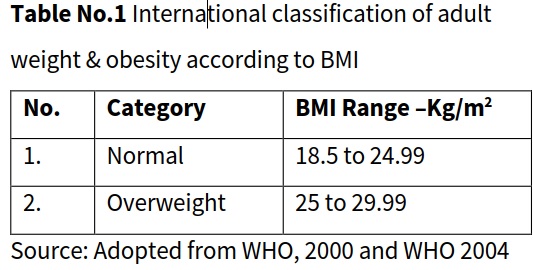
BODY MASS INDEX = weight in kilograms / (height in meter)2
Observation and Results:
In this study 217 individual having BMI i.e. 25-29.99 were enrolled in Group-A and another 217 were having BMI > 25 were recruited in Group-B randomly as per criteria of selection irrespective of religion, socio-economic status.
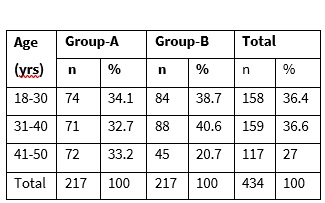
Table No.2 Age Wise Distribution of Participants.
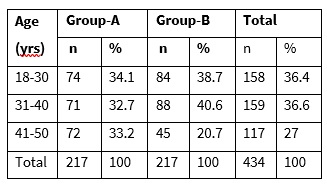
Table No. 3 Weight Wise Distribution of Participants.
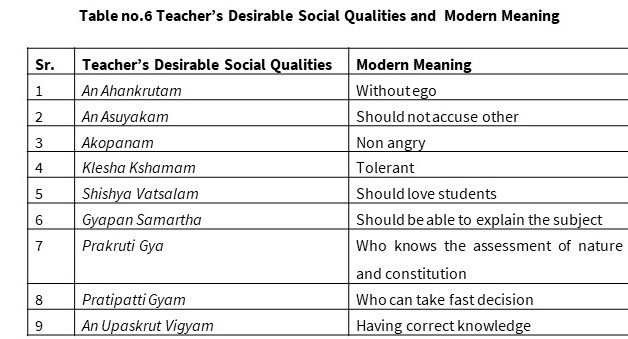
Table No.4 Ratio of measurements of Anguli praman and centimetres: Group-A
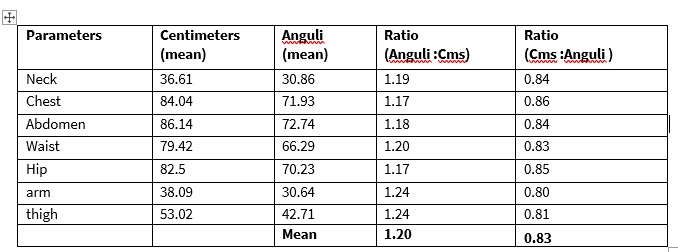
Table No.5 Ratio of measurements of Anguli praman and centimetres: Group-B
As per inclusion criteria of Participants were selected having age between 18 years to 50 yrs. and distributed it in three-sub age groups. Out of 434 Participants number of 158 [36.4%] Participants found in age group 18-30 years.159[36.6%] participants were in 31 to 40 yrs. While 117[27%] were found in 41-50 years of age.
In this study, in group A, 81(37.3%) participants were in range of 51-60 kg weight,132 (60.8%) were in 61-70 kg weight, while 4(1.8%) were in 71-80 kg of weight. In group B, no participant was in range of 51-60 kg weight, 43(19.8%) were in 61-70 kg weight, while 145(66.8%) were in 71-80 kg of weight, followed by 29(13.3%) were in range of 81.90 kg of weight.Totally,18.7% participants were lies in range of 51-60 kg weight,40.3% were in 61-70 kg, 34.3% were in 71-80 kg of weight while 6.7% in the range of 81-90 kg.The mean weight of Group A was 62.51 kg with SD ± 4.63, while mean weightobserved in Group B was 74.97 kg with SD ± 4.61.Overall mean weight of participants 68.74 kg with SD ± 7.76. In this study, in group A, 30(13.8%) participants were in range of 1.51-1.60 meters height, 187(86.2%) were in 1.61-1.70 meters height.
In group B, 20(9.2%) participants were in range of 1.51-1.60 meters height, 180(83%)were in 1.61-1.70 meters height ,13(6%) were in the range of 1.71-1.80 meter of height while 4(1.8%) were tallest among all.
Total, 50(11.5%) participants were in range of 1.51-1.60 meters height, most of 367(84.6%) were in 1.61-1.70 meters height, few were tallest among all. Overall mean height of participants 1.65 meter with SD ± 0.04.
The average BMI of group A was found to be 23.07 kg/m2 with SD 1.38, while in Group B it was found 27.25 kg/m2 with SD 1.46, and overall it was 25.16 with SD 2.53.
The ratio for measurements Angulipraman and centimeters was drawn in Group A , for the recruited participants whose BMI was within range of 18 to 24.99 kg/m2, the ratio Anguli : Cms was 1:1.20 and vice versa Cms : Anguli was 0.83 It was concluded from this study that One Anguli is tentatively 1.20 centimeters long or 0.83 Anguli is equivalent to one centimeters in those participants whose BMI was within range of 18 to 24.99 kg/m2.
The ratio for measurements of Angulipraman and centimeters was drawn in Group B , for the recruited participants whose BMI was within range of 25 to 29.99 kg/m2, the ratio Anguli : Cms was 1:1.20 and vice versa Cms : Anguli was 0.83. It was concluded from this study that One Anguli is tentatively 1.20 centimeters long or 0.83 Anguli is equivalent to one centimeters in those participants whose BMI was within range of 25 to 29.99 kg/m2. It further concluded that Anguli pariman will be the same for measurement in non-obese or obese participants; only the obese participants were having higher value in some body anthropometry than in normal participants.
Discussion
Anguli Pramana is a better tool to describe measurements compared to absolute measurements. It gave in the first place, a unit of measurement. Angulipraman for every individual is the standard measurement given in Samhitas for various organs. According modern science Obesity is measured by BMI Body Mass Index, however after a specific year height remains constant so it might affect the BMI impression to decide whether a person having its abnormal measurements so it is need to evaluate some standard procedure based on Anguli Praman which will predict the accuracy in determining body proportion as per weight and its co relation with height of human being. Anguli pramana which is based on swa-angula pramana is used for measuring the dimensions (Ayama,
vistara, and parinaha etc) of the different anga-pratyangas of the body. The Person having Anguli Pramana more than 84 Angula or less than 84 Angula will have Ayu, bala, oja, etc. Madhya (moderate) or heen (Poor). But in today’s period before measuring those dimensions, the physician should be aware of the unit “Anguli” in terms of centimeters. Ancient Indian measurements related to the body are correlated to the finger measure. Among the Dasavidha pareeksha, the examinations of the sara, samhanana and pramana require some anatomical knowledge. Sharira pramana or measurements pertaining to the body have described in all Samhitas giving us an insight of body sharir and praman of pratyanga. Anguli Sthana Nishchiti should be done at the site of Average of right and left hand, medio?lateral proximal interphalangeal joint of middle finger.
Conclusion
The ratio for measurement of Angulipraman and centimeters in Group A, the ratio Anguli :Cms was 1:1.20 and vice versa Cms : Anguli was 0.83. It was concluded from this study that One Anguli is tentatively 1.20 centimeters long or 0.83 Anguli is equivalent to one centimeters in those participants whose BMI was within range of 18 to 24.99 kg/m2.
The ratio for measurements of Angulipraman and centimeters in Group B, whose BMI was within range of 25 to 29.99 kg/m2, the ratio Anguli : Cms was 1:1.20 and vice versa Cms : Anguli was 0.83. It was concluded from this study that One Anguli is tentatively 1.20 centimeters long or 0.83 Anguli is equivalent to one centimeters.
References
value="
- Sushruta, Sushrutsamhita, with Dalhan. In: Achary YT, editor, Nibandhasangraha commentary. 1st ed. Varanasi, Uttar Pradesh, India: Chaukhambha Surabharati Publication; 1994. p. 65.
- Physical Status: Use and Interpretation of Anthropometry, W.H.O. Technical Report Series. Geneva: W.H.O. Publication Dept.; 1995. p. 1?47.
- Charka samhita, Pandit Kasinath Panday et. al., Chaukhambha bharati academy, Varanasi 2005 Page no 779.
- Sushruta. Kaviraj ambikadatta shastri , editor. Susruta Samhita of Maharshi Sushruta with Ayurved Tatava Sandipika, Kashi Sanskrita Grantaha Mala. Series 156 reprint 2007 page no 130.
- Shastri Girijashankar Mayashankar Acharya Charaka, Charak Samhita, Sutrastan: Chapter 21, Verse 9, (3rd edition) Ahmedabad: Sastu Sahitya Vardhaka Karyalaya,1981;169
- Integrated Disease Surveillance Project reports (IDSP) Non-Communicable Disease Risk Factors Survey, 2007-08 Maharashtra, ICMR, Ministry of Health & Family Welfare, Government of India. Page No.33-35.
- Shashikant K. Muley, Ajit A. Surve, Swati D. Bhingare: Scientific study of Charakokta Anguli Pramana in reference to human height, AYU | Oct-Dec 2013 | Vol 34 | Issue 4.p.356-359.
"

